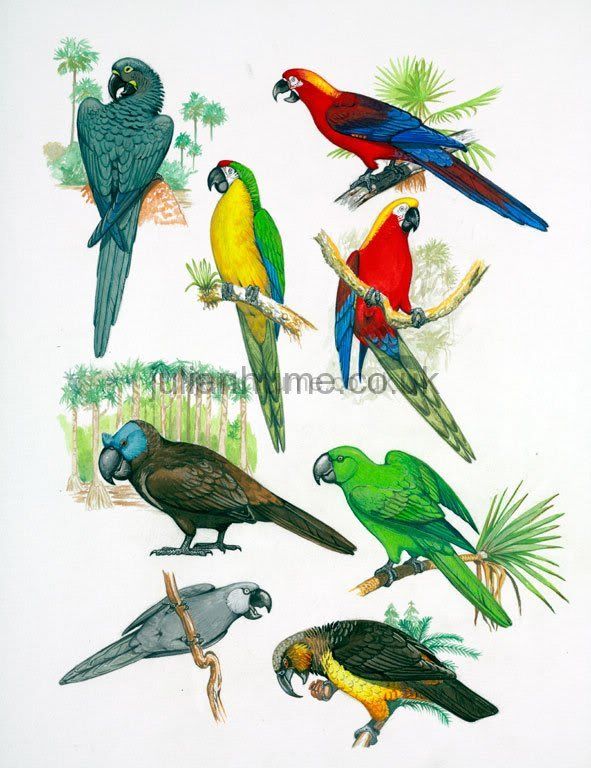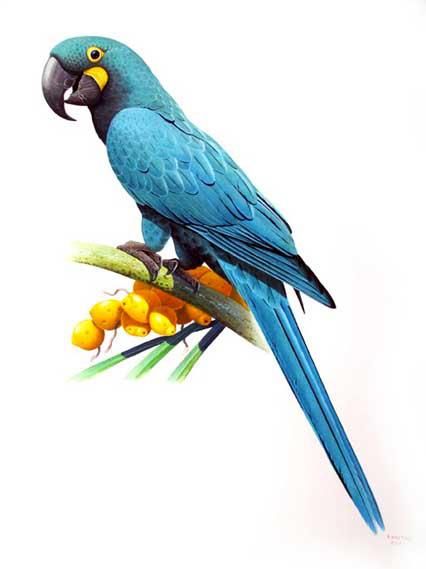|
|
Post by RSN on Sept 18, 2011 4:50:46 GMT
Extinct Parrots by Julian Hume Clockwise from top right: Cuban red macaw ( Ara tricolor) - extinct 1864, Cuba, West Indies; Jamaican red macaw ( Ara gossei) - extinct 1765, Jamaica, West Indies; Rodrigues parrot ( Necropsittacus rodericanus) - extinct 1762, Rodrigues Island, Mascarenes; Norfolk Island kaka ( Nestor meridionalis productus) - extinct 1851, Norfolk Island; Thirioux’s grey parrot ( Psittacula bensoni) - extinct c 1764, Mauritius, Mascarenes; broad-billed parrot ( Lophopsittacus mauritianus) - extinct 1674, Mauritius, Mascarenes; Dominican green and yellow macaw ( Ara atwoodi) - extinct 1791, Dominica, West Indies; glaucous macaw ( Anodorhynchus glaucus) - extinct c 1960, South America.
|
|
|
|
Post by surroundx on Sept 18, 2011 5:15:35 GMT
|
|
|
|
Post by RSN on Jan 24, 2012 13:27:35 GMT
 Painting by Eduardo Brettas |
|
|
|
Post by surroundx on Jul 8, 2012 5:47:13 GMT
|
|
|
|
Post by Peter on Jul 14, 2012 7:51:06 GMT
Abstract: Anodorhynchus glaucus and A. leari: osteology, fossil records and former geographic distribution. Of the blue macaws of the genus Anodorhynchus, A. hyacinthinus is the largest and occupies open areas in CS South America, mainly in Brazil. The smaller A. leari and A. glaucus occurred in quite similar habitats in east and southern South America, both being considered critically endangered. Anodorhynchus leari occurs in northern Bahia State, Brazil, and A. glaucus was distributed in southern South America, being originally found in southern Brazil, Paraguay, Uruguay and northern Argentina, now extinct at least in most of these areas. These species differ only in rather subtle plumage characters whereas there are no osteological differences between them. Fossils found in caves of the states of Bahia and Minas Gerais, between the historically known ranges of A. leari and A. glaucus suggest that the blue macaws of E South America had a contiguous distribution until at least 10.000 years ago, so A. leari is best treated as a subspecies of A glaucus.. ----------------------------------------------------------------------------- This would mean a change in its taxonomy (if accepted of course): - Glaucous Macaw: Anodorhynchus glaucus glaucus (Vieillot, 1816)
- Lear's Macaw: Anodorhynchus glaucus leari (Bonaparte, 1856)
|
|
|
|
Post by surroundx on Jul 14, 2012 9:30:39 GMT
Thanks for the translation Peter. I didn't actually know what the article was about! 2007 was 5 years ago so if we ask a macaw specialist they should be able to tell us whether this suggested taxonomic change has been accepted by now.
I remember that a female A. leari in one of the zoos in Europe was apparently identified as an A. glaucus by several macaw specialists. So I think that even their colours are extremely similar to each other.
|
|
|
|
Post by Peter on Jul 15, 2012 18:52:52 GMT
It is just the English abstract in the paper.  But I guess this taxonomic change has not been widely accepted (yet). For example, BirdLife still sees them as separate species. But if there are no osteological differences between them, it seem a valid conclusion to me (even BirdLife mentions that "Lear's Macaw A. leari has a bluer head and is not sympatric, but specimens in trade could be confused"). If we had only bones from these two species I think they would have been classified as the same species. Maybe we need genetic conformation first? |
|
|
|
Post by RSN on Dec 30, 2014 2:21:05 GMT
 One of the watercolors I made for the exposition "Aves e Evolução: Uma Perspectiva Histórica" (Birds and Evolution: A Historical Perspective), which was on display at the 21st Brazilian Ornithological Congress (December 2014). |
|
|
|
Post by Peter on Dec 30, 2014 8:10:03 GMT
That is an amazing good painting Rafael! Thanks for sharing and great to hear it was on display. You are a true artist.
|
|
|
|
Post by Melanie on Dec 30, 2014 10:00:45 GMT
Fantastic, Rafael. Thanks for sharing this amazing painting. Keep on the good work.
|
|
|
|
Post by RSN on Jan 1, 2015 18:57:55 GMT
|
|
|
|
Post by Sebbe on Jan 2, 2015 17:56:09 GMT
Really amazing artwork, thanks for sharing with us  |
|
|
|
Post by RSN on Jan 4, 2015 23:58:35 GMT
Thank you very much Sebbe!  |
|
|
|
Post by RSN on Nov 8, 2016 17:46:37 GMT
Papavero, N.; Teixeira, D. M. (2016) Um breve histórico das araras do gênero Anodorhynchus Spix, 1824 (Aves, Psittaciformes). Arquivos de Zoologia 47 (1). Abstract Since the Antiquity, parrots, parakeets and their relatives (Psittacidae) aroused a great interest in Europe, both for their colours as for their notorious capacity of interacting with human beings. With the discovery of the Americas, new species would be introduced in the traffic of exotic animals a long time ago established by Europeans with Africa and the East. Effectively, even before Columbus finished his fourth and last voyage (1502-1504), neotropical parrots had already made their appearance in chronicles, in the cartography and the fine arts. Although the oldest notices about blue macaws of the genus Anodorhynchus date from the end of the 16th century, and the first image from the beginning of the 17th century, those birds would be better known by Europeans only in the second half of the 18th century. In a general way, the sources examined herein proved to be especially significant for Anodorhynchus glaucus, as all the first hand information about the biology and the behavior of this macaw are registered in testimonies prior the 20th century. It is not impossible to suppose, therefore, that further details about this species and a better understanding of its mysterious disappearance could be obtained from the perusal of the vast documentary collection about the Rio de la Plata basin left by Jesuits, as well as from a more accurate reading of the reports by travelers and naturalists which, such as Friedrich Sellow and Auguste de Saint Hilaire, journeyed through Argentina, Paraguay, Uruguay, and southern Brazil. Full text in Portuguese: www.revistas.usp.br/azmz/article/view/111141 |
|
|
|
Post by RSN on Dec 21, 2018 2:36:30 GMT
|
|
|
|
Post by Sebbe on Mar 20, 2020 19:46:47 GMT
|
|
|
|
Post by redpinnipedgamer on Aug 9, 2024 23:57:50 GMT
|
|
|
|
Post by Sebbe on Nov 12, 2024 15:04:41 GMT
It was assessed as Extinct in the 2022 edition of the Brazilian Red List. |
|